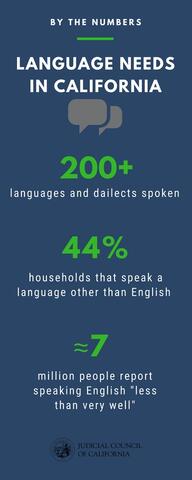Language Access
- There were 630,965 statewide interpretations during fiscal year (FY) 2021–22.
- Languages and dialects spoken in California—more than 200
- Percentage of Californians that speak a non-English language at home: 44%
- Percentage of Californians with English-language limitations: approximately 17.2% (approximately 6.4 million)
- Languages certified for court interpreters: American Sign Language and 12 spoken languages—Arabic, Armenian (Eastern), Cantonese, Farsi (Persian), Korean, Mandarin, Portuguese, Punjabi (India), Russian, Spanish, Filipino (Tagalog), and Vietnamese
- The top 10 most interpreted languages in courtroom proceedings statewide: Spanish (89%), followed by American Sign Language, Vietnamese, Mandarin, Cantonese, Korean, Punjabi, Russian, Arabic, Farsi, and Tagalog.
What is Language Access?
Language access allows limited English proficient (LEP) individuals access to a wide range of services. As defined by the U.S. Department of Justice, LEP individuals are persons who do not speak English as their primary language and have a limited ability to read, write, speak, or understand English.
How Language Access Impacts Court Users
On January 22, 2015, the Judicial Council adopted the Strategic Plan for Language Access in the California Courts, which provides a consistent statewide approach to ensure language access for all LEP court users in California in all 58 superior courts.
Court Interpreter Pool
As of July 2024, there are 1,820 interpreters on the Judicial Council Master List of certified and registered court interpreters.
Multilingual Resources for LEP Court Users
The Language Access Toolkit contains multilingual resources to help LEP court users understand how to work with an interpreter and better understand the court process.


